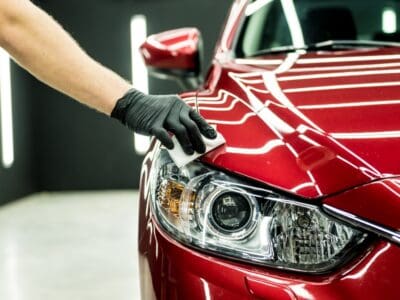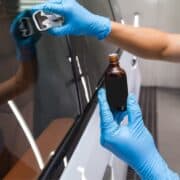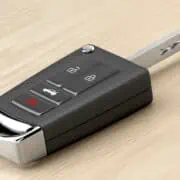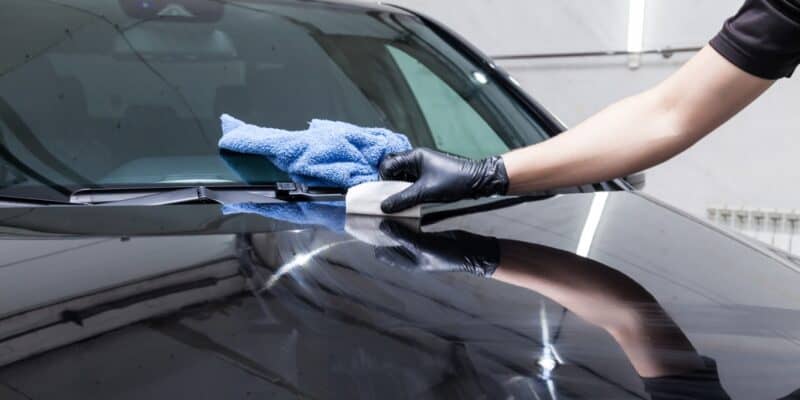
Your car is more than just a means of transportation. It’s a reflection of your personality and style. So, it’s only natural to take pride in its appearance and want to protect it from the elements.
That’s where ceramic coating comes in.
But how much does ceramic coat cost, and is it worth it?
This article will explore the cost of ceramic coating and help you decide if it’s a wise investment for your car’s protection and aesthetic appeal.
What Is Ceramic Coating?
Ceramic coating, also called nano-ceramic coating, is the ultimate solution for protecting your car’s exterior from damage. This chemical polymer solution creates a semi-permanent or permanent shield (depending on the coating) resistant to the elements—rain, snow, and intense heat waves.
Applied manually, the silicon dioxide solution bonds with the car’s paint to form an extra hydrophobic layer that prevents damage from dirt, stains, tree sap, bird droppings, bug splatter, and other contaminants. It’s similar to waxing, but ceramic coating provides long-lasting protection, unlike waxing.
Keep reading to learn more about the average ceramic coat price and if it’s worth the investment.
How Much Is Ceramic Coating: Complete Breakdown?
Prices vary between pro detailers. However, here’s a breakdown of the expenses you can expect.
Note
Light Ceramic Coating Package
1-Step Paint Correction/Light Coating = $400–700
2-Step Paint Correction/Light Coating = $800–1200
3-Step Paint Correction/Light Coating = $1500–2000
1-3 Year Ceramic Coating Package
1-Step Paint Correction/1-3 Year Coating = $500–800
2-Step Paint Correction/1-3 Year Coating = $1000–1500
3-Step Paint Correction/1-3 Year Coating = $1800–2500
3-5 Year Ceramic Coating Package
1-Step Paint Correction/3-5 Year Coating = $700–1000
2-Step Paint Correction/3-5 Year Coating = $1500–2500
3-Step Paint Correction/3-5 Year Coating = $3000 upwards.
Professional Grade Ceramic Coating Cost vs. DIY
A professional-grade ceramic coat can cost anywhere from a few hundred to a few thousand dollars, depending on the vehicle’s size and the job’s complexity. The cost may also vary depending on the brand of ceramic coating product used and the installer’s expertise. Some professional-grade ceramic coatings come with warranties of several years, especially those that layer several products instead of just one.
On the other hand, if you have the time, patience, and expertise, you can opt for a do-it-yourself (DIY) ceramic coating kit. These kits can cost between $100 and $700, depending on the brand and the selection of items in the kit.
While a DIY kit seems significantly cheaper than a professional-grade ceramic coat job, the process is time-consuming and requires skill. If you aren’t sure what you’re doing, you may waste the product, end up with an uneven terribly-looking finish, or a subpar finish that’s anything but durable.
Ultimately, the decision between professional-grade ceramic coating and DIY kits comes down to personal preference, budget, and the level of protection and durability you want for your car’s exterior.
What Determines Ceramic Coating Cost?
There’s no one-size-fits-all price for ceramic coating. The service costs anywhere from $250 to over $3000. That’s because several factors affect the price of a ceramic coat. Let’s look at some of them:
Prepping the Car
To ensure that a ceramic coat bonds well to the paint and lasts for a long time, it’s important to prep the car’s surface properly.
The first step in the prepping process is to wash the car to remove surface dirt. Next, the paint surface is decontaminated using a clay bar to remove embedded dirt and provide a smooth feel.
After decontamination, an iron remover is sprayed on the car’s surface to break down any remaining contaminants. Removing contaminants is crucial because the polishing stage uses a buffer that rotates a pad at high speeds. This may scratch the paint surface if contaminants are present.
The paint correction stage comes next. It involves polishing imperfections, swirl marks, or scratches on the paint’s surface. A panel wiping procedure is then carried out to remove any residue left from the paint correction stage.
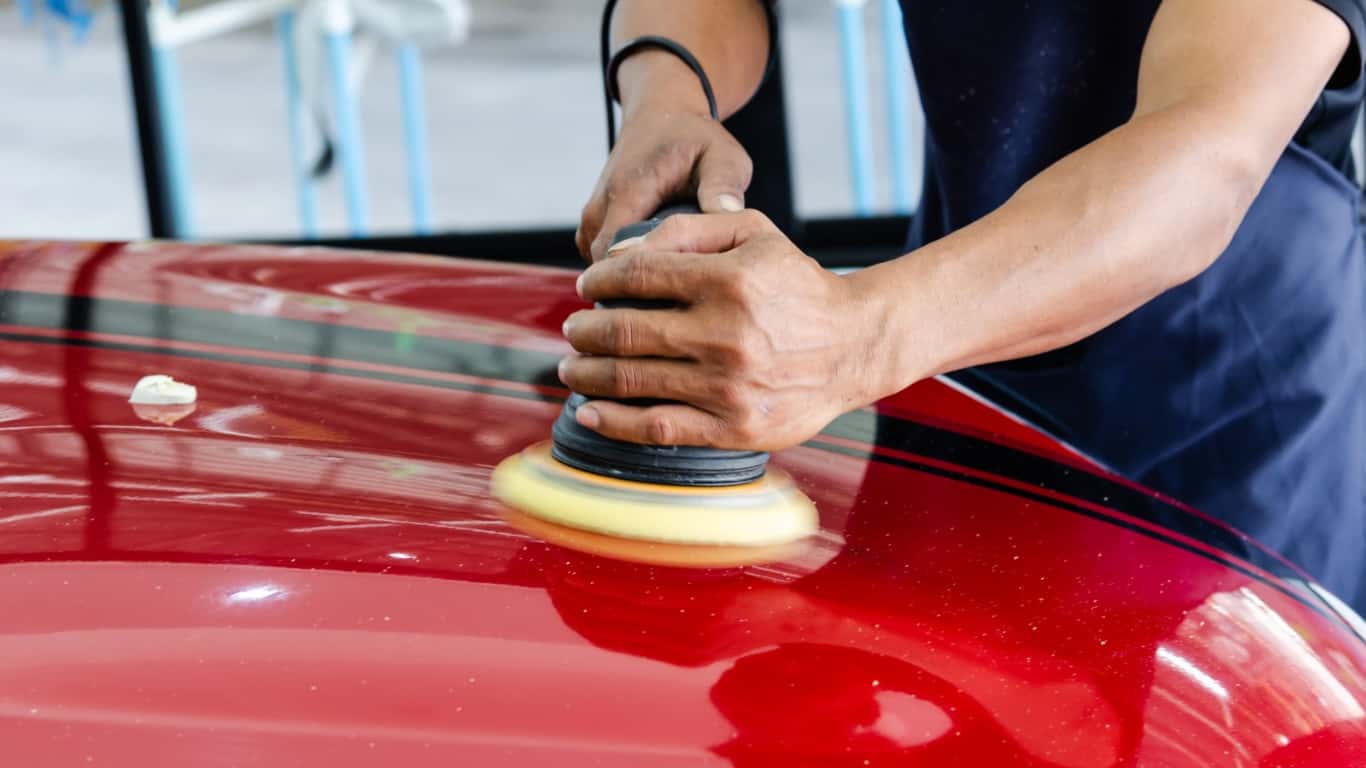
With that, prepping is complete, and the preferred ceramic coating can be applied. However, you can already see that this is a laborious and time-consuming task.
Here’s a summary of the prepping process:
- Washing
- Decontaminating with a clay bar
- Utilizing an iron remover
- Paint correction
- Panel wiping
Paint Correction Level
Prepping is a pretty robust process that includes paint correction. However, the level of paint correction needed before the ceramic coat is applied also affects the price.
For starters, paint correction involves using a polisher and buffing compound to remove minor scratches and swirls from a vehicle’s clear coat. This is important, as ceramic coating a car with scratches will remove the luster from the finish.
There are three levels of paint correction, depending on how deep the scratches are. Entry-level correction is excellent for light scratches, while two-step and three-step corrections are for progressively deeper markings.
Protection Duration
The type of ceramic coat used determines how long the results will last and how expensive the package will be. Light formulas that come in entry-level ceramic coating packages are relatively cheap and easy to apply. They are expected to last for about a year.
Higher packages demand more robust, double-layered coats that can last for 2–5 years, depending on the quality of the product. Of course, they also take longer to complete and require more expertise to achieve optimal results.
Some products claim to last 10 years or more, but this is rare. Plus, it’s worth noting that these figures are usually best-case scenarios. So, unless you’re locking your car up in a showroom, you’ll likely need a new coat earlier than that, especially if you live in areas of extreme temperatures or poorly maintain the car.
Speaking of maintenance, washing is enough for the most part. Be cautious of stronger treatments, such as claying and polishing, as these can reduce the lifespan of the coat.
Labor
You can probably already tell that labor is a big reason why professional ceramic coating procedures are expensive. A typical job can take several days to complete, thanks to all the processes described above.
Advantages of Ceramic Coating
If you’re a car owner, you’ve probably heard about ceramic coating and how it can protect your vehicle’s exterior from damage. But what exactly is a ceramic coat, and what are its advantages?
Durability
Ceramic coating is a liquid polymer that creates a protective layer over your car’s paint. It provides a high-gloss finish and repels water, dirt, and other debris. It’s also scratch-resistant, so your vehicle will look new for longer.
Protection Against External Factors
Another aspect of a ceramic coating’s durability is its protection against external factors such as the sun’s UV rays, heavy rain, and other weather hazards. This prevents your paint from fading or oxidizing over time.
Easier Cleanup
Ceramic coating makes it easier to clean your car. The hydrophobic surface it creates repels water and other liquids, making it harder for water spots to form.
Extra Gloss
Ceramic coatings create a high-gloss finish that enhances your vehicle’s appearance. The surface will look shiny and new for longer, even after multiple washes.
Maintaining Ceramic Coating
You can do certain things to keep your ceramic coat intact for longer. Here are some of them:
- Wash your car regularly (every two weeks, for example)
- Use the two-bucket car wash method
- Utilize a ceramic coating specific car shampoo
- Avoid washing your vehicle in direct sunlight
Failure to maintain the ceramic coating of your car can lead to the following:
- Loss of glow on your car’s surface
- Diminished hydrophobic effects
- Failure of the nano-coating to do its job
Where Else Can I Use Ceramic Coating?
While ceramic coating is commonly applied to a car’s paintwork, you can use it on other surfaces to achieve a full-coverage shine. Plastic trims, headlights, and glass windows are all surfaces that can benefit from ceramic coating. Even tires can be ceramic coated. However, it’s important to carefully read the instructions provided by the manufacturer to ensure that the product suits these surfaces.
When applied to these surfaces, ceramic coating protects them from damage and improves their appearance. For example, coating plastic trims and headlights prevents them from fading or yellowing over time. Similarly, coating glass windows makes them more resistant to scratches and chips, alongside adding an extra layer of UV protection.
Like car paint, ceramic coating other surfaces requires careful attention to detail and proper technique. Hence, read the instructions carefully and follow them closely to achieve the best results.
Ceramic Coating vs. Waxing: What’s the Difference?
Ceramic coating and waxing are two popular methods of protecting a car’s paint, but they are pretty different in how they achieve this.
For starters, waxing provides a layer of protection that can last for a few weeks, while ceramic coating creates a more durable and long-lasting barrier against damage. Ceramic coating is also more resistant to scratches and fading and provides a high-gloss finish you can’t achieve with waxing.
Another significant difference between ceramic coating and waxing is the level of preparation required. Waxing can be done at home with minimal preparation, but ceramic coating requires extensive preparation, including washing, polishing, and even paint correction.
In terms of cost, ceramic coating is generally more expensive than waxing, but it also lasts longer and provides better protection.
Deciding between ceramic coating and waxing comes down to the level of protection and shine you seek and your budget. Waxing is a good option if you’re looking for a quick and easy way to protect your car’s paint, but it’s short-lived. Ceramic coating, on the other hand, provides a much more durable and long-lasting solution.
Is Ceramic Coating Worth The Cost?
Yes, ceramic coating is worth the cost.
While a ceramic coat price may be higher than traditional waxing, it provides long-lasting damage protection, easier maintenance, and an enhanced appearance with extreme UV protection, hydrophobic properties, and prevention against oxidation.
Even though waxing is cheaper, it doesn’t last as long as a ceramic coat. So, you might spend more waxing your car several times a year than applying a high-grade ceramic coat once in a few years.
Overall, the durability and longevity of ceramic coating make it a worthwhile investment for those who want to keep their car looking great for years to come.
Invest in the Best Ceramic Coat for Your Car
Ceramic coating is a valuable investment for car owners who want to keep their vehicles looking new for longer. While the initial cost may be higher than traditional waxing, the benefits of ceramic coating make it worth it in the long run.
It provides unparalleled durability, protection against external factors, extreme UV protection, and hydrophobic properties that make cleaning easier. Additionally, ceramic coating adds a layer of gloss and shine to the vehicle, making it look more polished and well-maintained.

